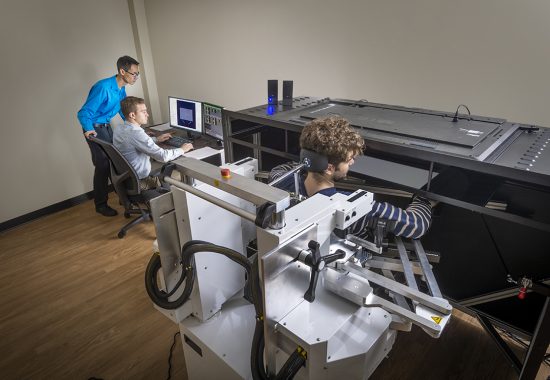
The athletic prowess seen in sporting events like the Olympics and the musical skills demonstrated at concerts highlight the amazing variety and complexity of skillful behaviors that humans are capable of producing. These and many other actions performed throughout daily life rely on at least two critical abilities. The first is the ability to quickly learn new behaviors through imitation. For example, when learning to dance, people often watch an instructor demonstrate a move and then attempt to copy it. Humans have a remarkable ability to imitate others, even without ever having seen a particular movement before. With this ability, people don’t have to spend a long time trying different actions to figure out how to successfully accomplish a task. The second critical ability is the use of tools such as hammers and saws, sporting equipment, musical instruments, and so forth. Tools increase the number of ways that individuals can influence their environments, helping them accomplish a much wider range of things than might otherwise be possible. However, tools are only helpful to people if they have the ability to properly manipulate the tools to achieve their desired effects.
Although on the surface imitation and tool use seem like two very different abilities, they are surprisingly related to each other. Their relationship is highlighted by the observation that losing the ability to imitate and to use tools are the two hallmark impairments of a neurological disorder known as limb apraxia. Limb apraxia can be observed in many common neurological disorders such as Parkinson’s disease, Alzheimer’s disease, and Autism Spectrum Disorder, although it is most commonly studied in individuals who have had a stroke on the left side of their brain. In fact, apraxia can be detected in roughly 50% of people who have a left-hemisphere stroke (about 200,000 people each year in the United States). Apraxia is unusual because although it affects the ability to move, it cannot be explained by the typical underlying movement problems, like muscle weakness or paralysis, that are commonly observed after a stroke – particularly as apraxic impairments can be detected on the less affected side of the body. Despite that, the presence of apraxia is one of the best indicators of poor recovery and caregiver reliance after experiencing a stroke. Unfortunately, understanding exactly what the problem is, and why imitation and tool use are the two abilities specifically affected, remains a puzzle despite over 100 years of investigation into this disorder.
Eight years ago, Dr. Aaron Wong, Dr. Laurel Buxbaum, and Dr. John Krakauer realized that a new approach would greatly benefit our understanding of apraxia. Although apraxia is a disorder that resides somewhere along the spectrum between high-level cognition and low-level control of movement, it had until that point rarely been studied by neuroscientists with a primary background in investigating the control of movement. This unfortunately had resulted in theories about apraxia that were somewhat disconnected from current views about the way in which the brain actually plans and controls movements. By combining the expertise of individuals who study apraxia with those who study the neuroscience of movement, it would be possible to develop a more comprehensive and contemporary understanding of apraxia.
This approach has culminated in the recent receipt of a five year, $2.2 million grant from the National Institutes of Health (NIH) to conduct a series of studies testing a novel theory about what might have gone awry in individuals with apraxia. This grant is being led by Dr. Wong, Director of the Cognitive-Motor Learning Laboratory at Moss Rehabilitation Research Institute (MRRI). MRRI Associate Director Dr. Buxbaum, and long-time collaborators Dr. Krakauer at Johns Hopkins University and Dr. Branch Coslett at the University of Pennsylvania, will contribute to the project as co-investigators. The novel theory proposed by these investigators posits that part of the difficulty in nailing down the specific problem caused by this disorder is because individuals may actually plan imitation and tool-use movements in two distinct ways. First, people can specify how to move various parts of their body relative to each other. For example, tennis coaches sometimes tell their players to focus on where their elbow is positioned relative to their hand during a tennis serve. Alternatively, people can plan the desired motion of their hand as it moves through space, without also worrying about the motion of the rest of the arm. For example, a tennis player might instead focus on producing a smooth arcing motion of the racket as it moves to hit the ball. Dr. Wong’s recent work has not only shown that people are able to use these two distinct strategies when preparing a movement, but also that impairments when imitating bodies or motion paths are associated with strokes to different parts of the brain.
Dr. Wong’s team will test their new theory using a variety of tools including carefully measuring the behavior of individuals with left-hemisphere strokes, as well as examining the specific locations in the brain that may be responsible for these impairments using state-of-the-art lesion-symptom mapping techniques as well as transcranial magnetic stimulation. Experiments to test this theory for imitation are currently underway, and Dr. Wong is looking forward to expanding this work to study tool-use abilities in early 2022. If borne out, this research will lay the groundwork for developing new rehabilitation approaches that could train people to leverage the movement strategy that is less affected by the stroke (that is, by focusing on whole-arm positions versus hand paths) in order to overcome imitation and tool-use impairments. This NIH-funded study illustrates MRRI scientists’ expertise in developing innovative theory-driven research projects with the long-term goal of improving clinical treatments in neurorehabilitation.


228 comment on “MRRI Receives NIH Grant to Study Apraxia and Potential Pathways to Target in Rehabilitation”